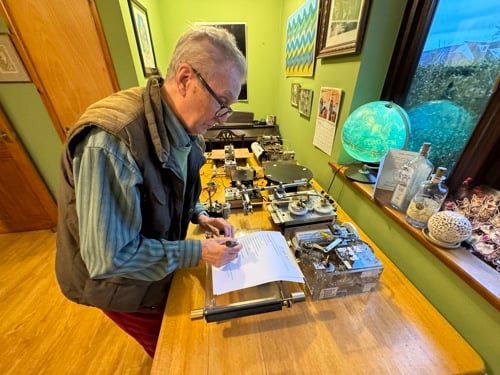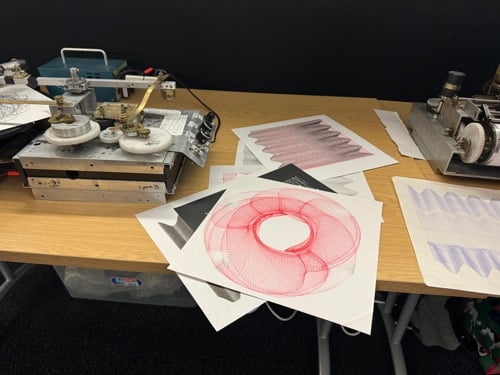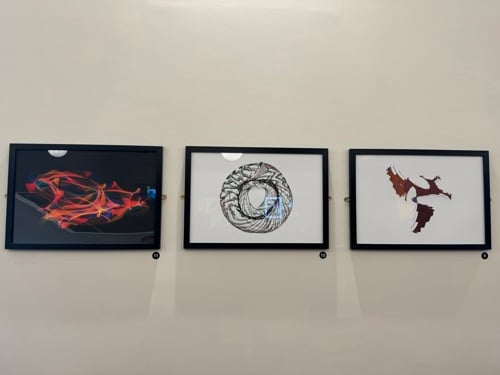Long-time Computer Arts Society member Dr Jack Tait has been creating drawing machines since 1960. A new CAS exhibition of his work at the Phoenix Cinema and Art Centre in Leicester explores his creative techniques as he traces a line between order and chaos. As part of our monthly focus on the CAS' activities, Dr Sean Clark, Computer Arts Society Chair, reflects on Jack’s creativity.
Jack Tait constructed his first drawing machine in 1960. In the more than 60 years since then (Jack has recently turned 90) he has continued to build new machines and create new artworks. Several of his machines are now in the Science Museum collection, he was the subject of a special issue of the Computer Arts Society’s PAGE newsletter in 2007, and in 2011 he obtained a PhD from Manchester MIRIAD entitled Programmable Analogue Drawing Machines. In 2024 he generously donated a collection of drawing machines to the Computer Arts Archive in Leicester.

Electro-mechanical intricacy
When you see one of Jack’s drawing machines in operation, the first thing you notice is the intricacy of the mechanism. Cogs, linkages and motors all combine to control a pen or pens to slowly create intricate patterns. Different machines create different styles of drawing, but they all have one thing in common: they are analogue. While Jack has experimented with digital drawing devices during his career, his focus has always been to create analogue machines.
These machines create ‘generative art’ in a very true sense, but the process of image-making is electro-mechanical — not driven by a computer program. The ‘algorithm’ is effectively embedded in the machine through Jack’s choice of cogs and linkages. It is not, however, deterministic — different starting positions, flexibility in the mechanism and user control ensure that every drawing made by a machine is unique. These endless possibilities are further enhanced by a mechanical ‘programmer’ that allows changes to the drawing machine’s settings to be automated.

Jack’s work is reminiscent of that of another drawing machine pioneer, Desmond Paul Henry, who modified a Second World War mechanical bombsite computer to create drawings. Indeed, Jack Tait reverse-engineered Henry’s drawings to create his own Homage to Henry machine.
Changing processes
Jack’s process does not always end with the drawings. He has developed a technique whereby he will often scan the output of a drawing machine into a computer and use image manipulation software to embellish it, identifying parts of the pattern he is interested in and emphasising or colourising them. He also makes use of his skills as a photographer by replacing the pen with a light source, such as an LED, and capturing the movement as a slow-exposure photograph — quite literally drawing with light.
For you
Be part of something bigger, join BCS, The Chartered Institute for IT.
For many years, Jack’s interest has been in exploring randomness and the point at which structure within an image breaks down and the result is chaotic. Many of his most interesting images are produced when the mechanical parts are closely tuned, but not identical. Just a tiny change in the ratio between two cogs can lead to huge amounts of complexity in the image. Likewise, randomness — produced electro-mechanically, of course — can add variety to a machine and lead to unexpected results.
The BCS exhibition

The 20 artworks on display in the Leicester exhibition include images that date from 1972-2023 and cover most of Jack’s techniques. There is also a video Q&A with Jack on the exhibition web page and a free PDF copy of his book Programmable Analogue Drawing Machines, based on his PhD thesis. The exhibition will be on show at Phoenix in Leicester until early June and will be moving to BCS Moorgate in December when an exhibition catalogue will also become available. We hope to bring at least one of Jack Tait’s drawing machines to the Moorgate exhibition opening.
The title image used for this article was created by Jack Tait using one of his analogue drawing machines with a light pen and slow photographic exposure.

















